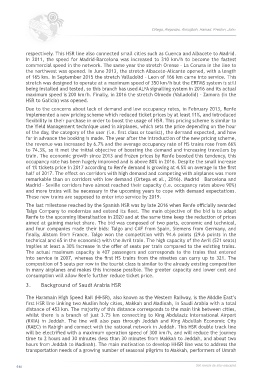Page 516 - 360.revista de Alta Velocidad - Nº 6
P. 516
Ortega, Alejandro. Almujibah, Hamad. Preston, John.
respectively. This HSR line also connected small cities such as Cuenca and Albacete to Madrid.
In 2011, the speed for Madrid–Barcelona was increased to 310 km/h to become the fastest
commercial speed in the network. The same year the stretch Orense – La Coruna in the line to
the northwest was opened. In June 2013, the stretch Albacete–Alicante opened, with a length
of 165 km. In September 2015 the stretch Valladolid – Leon of 166 km came into service. This
stretch was designed to operate at a maximum speed of 350 km/h but the ERTMS system is still
being installed and tested, so this branch has used ALFA signalling system in 2016 and its actual
maximum speed is 200 km/h. Finally, in 2016 the stretch Olmedo (Valladolid) – Zamora (in the
HSR to Galicia) was opened.
Due to the concerns about lack of demand and low occupancy rates, in February 2013, Renfe
implemented a new pricing scheme which reduced ticket prices by at least 11%, and introduced
flexibility in their purchase in order to boost the usage of HSR. This pricing scheme is similar to
the Yield Management technique used in airplanes, which sets the price depending on the hour
of the day, the category of the user (i.e. first class or tourist), the demand expected, and how
far in advance the booking is made. The year after the introduction of the new pricing scheme,
the revenue was increased by 6.7% and the average occupancy rate of HS trains rose from 66%
to 74.3%, so it met the initial objective of boosting the demand and increasing travellers by
train. The economic growth since 2013 and frozen prices by Renfe boosted this tendency, this
occupancy rate has been hugely improved and is above 80% in 2016. Despite the small increase
of 1% tickets price in 2017 according to Renfe demand is growing at 4.5% on average in the first
half of 2017. The effect on corridors with high demand and competing with airplanes was more
remarkable than on corridors with low demand (Ortega et al., 2016). Madrid – Barcelona and
Madrid – Seville corridors have almost reached their capacity (i.e. occupancy rates above 90%)
and more trains will be necessary in the upcoming years to cope with demand expectations.
These new trains are supposed to enter into service by 2019.
The last milestone reached by the Spanish HSR was by late 2016 when Renfe officially awarded
Talgo Company to modernize and extend its fleet. The main objective of the bid is to adapt
Renfe to the upcoming liberalisation in 2020 and at the same time keep the reduction of prices
aimed at gaining market share. The bid was composed of two parts, economic and technical,
and four companies made their bids: Talgo and CAF from Spain, Siemens from Germany, and
finally, Alstom from France. Talgo won the competition with 94.6 points (29.6 points in the
technical and 65 in the economic) with the Avril train. The high capacity of the Avril (521 seats)
implies at least a 30% increase in the offer of seats per train compared to the existing trains.
The actual maximum capacity is 407 passengers and corresponds to the trains that entered
into service in 2007, whereas the first HS trains from the nineties can carry up to 321. The
composition of 5 seats per row in the tourist class is similar to the already existing composition
in many airplanes and makes this increase possible. The greater capacity and lower cost and
consumption will allow Renfe further reduce ticket price.
3. Background of Saudi Arabia HSR
The Haramain High Speed Rail (HHSR), also known as the Western Railway, is the Middle East’s
first HSR line linking two Muslim holy cities, Makkah and Madinah, in Saudi Arabia with a total
distance of 453 km. The majority of this distance corresponds to the main link between cities,
whilst there is a branch of just 3.75 km connecting to King Abdulaziz International Airport
(KKIA) in Jeddah. The line will also pass through Jeddah and King Abdullah Economic City
(KAEC) in Rabigh and connect with the national network in Jeddah. This HSR double track line
will be electrified with a maximum operation speed of 300 km/h, and will reduce the journey
time to 2 hours and 30 minutes (less than 30 minutes from Makkah to Jeddah, and about two
hours from Jeddah to Madinah). The main motivation to develop HHSR line was to address the
transportation needs of a growing number of seasonal pilgrims to Makkah, performers of Umrah
514 360.revista de alta velocidad

